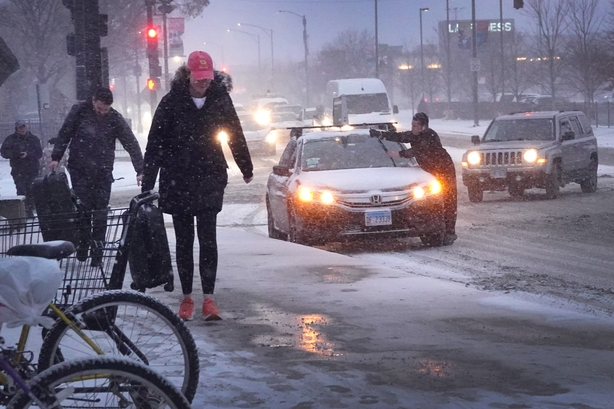A deep freeze enveloping most of the United States, combined with a massive winter storm brewing in the midwest, is to leave two-thirds of the nation under extreme weather alerts and confound travel plans for millions of Americans.
Heading into the Christmas holiday weekend, the looming storm was forecast to develop into a "bomb cyclone," unleashing heavy, blinding snow from the northern Plains and Great Lakes region to the upper Mississippi Valley and western New York.
Numbing cold intensified by high winds was expected to extend as far south as the US-Mexico border.
Hard-freeze warnings were posted across the Gulf Coast states of Texas, Louisiana, Alabama and Florida, while significant icing was possible from a separate arctic blast hitting the Pacific Northwest.
By late last night, most of the lower 48 states, from Washington state to Florida, were under wind-chill alerts, blizzard warnings or other winter weather advisories affecting more than 200 million people, about 60% of the US population, the National Weather Service (NWS) reported.
The ongoing major winter storm will continue to produce areas of heavy snow, strong winds, and life-threatening wind chills through Saturday. If traveling for the holiday, please use extreme caution and pay attention to the latest forecasts and updates. pic.twitter.com/WqMskJosNf
— NWS Weather Prediction Center (@NWSWPC) December 22, 2022
The NWS map of existing or impending wintry hazards, stretching from border to border and coast to coast, "depicts one of the greatest extents of winter weather warnings and advisories ever," the agency said.
The bomb cyclone could unleash snowfalls of 1.25cm (a half inch) per hour driven by gale-force winds, cutting visibility to near zero, the weather service said.
Combined with the arctic cold, wind-chill factors as low as -40C were forecast in the High Plains, the northern Rockies and the Great Basin, the NWS said.
Exposure to such conditions without adequate protection can cause frostbite within minutes.
What is a weather 'bomb cyclone'?
Power outages were expected from high winds, heavy snow and ice, as well as the strain of higher-than-usual energy demands.
One of the greatest immediate impacts, even before the storm fully took shape, was the upending of commercial air traffic during the busy holiday travel period.
Thousands of flights cancelled
Airlines cancelled nearly 4,000 US flights today, following nearly 3,000 cancellations yesterday, figures compiled b to flight tracking website FlightAware. Passenger railroad Amtrak has cancelled dozens of trains through Christmas, disrupting holiday travel for thousands.
The Federal Aviation Administration (FAA) imposed ground stops or delays for de-icing at a number of US airports because of winter weather.
It said "severe winter weather moving across the Great Lakes into the Northeast will have a major impact" on flights, adding that "flight delays are likely from Boston to D.C. Metropolitan area airports, Seattle-Tacoma and Portland International Airports and Aspen" in Colorado.
Seattle-Tacoma International Airport had 40% of departing flights cancelled as of 8.30am local time (2.30pm Irish time).
The FAA early issued a ground stop there due to snow and ice.
More than 40% of departing flights at Detroit Metro were cancelled and 18% at Chicago O'Hare.
Another 3,800 US flights were delayed today, including more than 14% of those operated by American Airlines, United Airlines, Delta Air Lines and Southwest Airlines.

The American Automobile Association had estimated that 112.7 million people planned to travel 80km or more from home between 23 December and 2 January, up 3.6 million travelers over last year and closing in on pre-pandemic numbers.
But that number was likely to be diminished by air and road travel complicated by treacherous weather leading into the weekend.
Even US President Joe Biden urged Americans to think twice about venturing out, calling the gathering storm "dangerous and threatening."
"This is not like a snow day, when you were a kid, this is serious stuff," he said in comments at the White House yesterday.

The extreme cold also posed a particular hazard to livestock in ranching-intensive regions of the country.
Tyson Foods Inc, the nation's leading meat producer by sales, said it had scaled back operations to protect employees and animals.
The weather service said relief from the deep freeze was in sight for the northern Rockies and High Plains, where the arctic blast first materialised yesterday.
Temperatures in parts of those regions could rebound by 40 to 60 degrees Fahrenheit over the weekend as the cold air mass creeps farther east.

